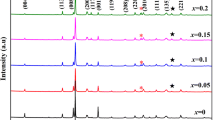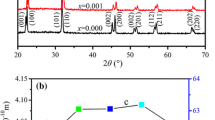Abstract
In order to research the effects of Li and Y (Li/Y) co-doping on BCZT ceramics, lead-free (Ba0.85Ca0.15) (Ti0.9Zr0.1) + xLi2CO3 + xY2O3 (abbreviated as BCZT-LixYx, x = 0, 0.1, 0.2, 0.3, and 0.4 mol%) piezoceramics were synthesized by traditional solid-state sintering method. The phase structure and microstructure of ceramic samples were researched through XRD and SEM. The electrical properties of ceramic samples were researched by piezoelectric, dielectric, and ferroelectric test instruments. The XRD spectrums indicate that ceramic samples have the perovskite structure. The SEM images show that the introduction of Li/Y in BCZT ceramics can promote grain growth and densification. The temperature-dependent dielectric performance testing results prove that BCZT-LixYx ceramic samples have apparent dielectric relaxation behavior. Moreover, co-doping Li/Y in BCZT ceramics can effectively decrease the sintering temperature from 1540 °C to 1400 °C and improve the electrical properties. The optimal electrical properties are obtained at x = 0.3 mol% (d33 = 526 pC/N, kp = 58%, εr = 4724, tanδ = 0.017, Tc = 75.5 °C, γ = 1.63, Pr = 9.73 µC/cm2, Ec = 2.10 kV/cm).










Similar content being viewed by others
References
J. Rödel, W. Jo, K.T.P. Seifeert, E.M. Anton, T. Granzow, Perspective on the development of lead-free piezoceramics. J. Am. Ceram. Soc. 92(6), 1153–1177 (2009)
J. Rödel, K.G. Webber, R. Dittmer, W. Jo, M. Kimura, D. Damjanovic, Transferring lead-free piezoelectric ceramics into application. J. Eur Ceram. Soc. 35(6), 1659–1681 (2015)
B. Wu, H.J. Wu, J.G. Wu, D.Q. Xiao, J.G. Zhu, S.J. Pennycook, Giant piezoelectricity and high Curie temperature in nanostructured alkali niobate lead-free piezoceramics through phase coexistence. J. Am. Chem. Soc. 138(47), 15459–15464 (2016)
P.K. Panda, B. Sahoo, PZT to lead free piezo ceramics: a review. Ferroelectrics 474(1), 128–143 (2015)
T. Zheng, J.G. Wu, D.Q. Xiao, J.G. Zhu, Recent development in lead-free perovskite piezoelectric bulk materials. Prog. Mater. Sci. 98, 552–624 (2018)
P.K. Panda, Review: environmental friendly lead-free piezoelectric materials. J. Mater. Sci. 44(19), 5049–5062 (2009)
M. Acosta, N. Novak, V. Rojas, S. Patel, R. Vaish, BaTiO3-based piezoelectrics: fundamentals, current status, and perspectives. Appl. Phys. Rev. 4(4), 041305 (2017)
Y. Zhang, H.J. Sun, W. Chen, A brief review of Ba(Ti0.8Zr0.2)O3-(Ba0.7Ca0.3)TiO3 based lead-free piezoelectric ceramics: past, present and future perspectives. J. Phys. Chem. Solids 114, 207–219 (2018)
W.F. Liu, X.B. Ren, Large piezoelectric effect in Pb-free ceramics. Phys. Rev. Lett. 103(25), 257602 (2009)
P. Wang, X.Y. Li, Y.Q. Lu, Enhanced piezoelectric properties of (Ba0.85Ca0.15)(Ti0.9Zr0.1)O3 lead-free ceramics by optimizing calcination and sintering temperature. J. Eur. Ceram. Soc. 31(11), 2005–2012 (2011)
Y. Zhang, H.J. Sun, W. Chen, Li-modified Ba0.99Ca0.01Zr0.02Ti0.98O3 lead-free ceramics with highly improved piezoelectricity. J. Alloys Compod. 694, 745–751 (2017)
X.M. Chen, X.Z. Ruan, K.Y. Zhao, X.Q. He, J.T. Zeng, Y.S. Li, L.Y. Zheng, C.H. Park, G.R. Li, Low sintering temperature and high piezoelectric properties of Li-doped (Ba,Ca)(Ti,Zr)O3 lead-free ceramics. J. Alloys Compd. 632, 103–109 (2015)
X.M. Chen, J.T. Zeng, D. Kim, L.Y. Zheng, Q.W. Lou, C.H. Park, G.R. Li, Understanding of role of Li in high-performance Pb-free Li-doped (Ba0.85Ca0.15)(Ti0.9Zr0.1)O3 piezoceramics from theory and experiments. Mater. Chem. Phys. 231, 173–180 (2019)
Y.C. Lee, Y.L. Huang, Effects of CuO doping on the microstructural and dielectric properties of Ba0.6Sr0.4TiO3 ceramics. J. Am. Ceram. Soc. 92(11), 2661–2667 (2009)
Z.M. Wang, X.F. Chen, X.L. Chao, J.J. Wang, P.F. Liang, Z.P. Yang, Low temperature sintering and dielectric properties of (Ba0.85Ca0.15)(Ti0.9Zr0.1)O3-xCu2+ ceramics obtained by the sol-gel technique. Ceram. Int. 42(16), 18037–18044 (2016)
S. Mittal, R. Laishram, K.C. Singh, Multi-phase coexistence in yttrium-substituted Ba0.9Ca0.1Zr0.07Ti0.93O3 lead-free piezoceramics. Ceram. Int. 45(1), 1237–1245 (2019)
Y.H. Wu, F. Ma, J.K. Qu, Y. Luo, J. Song, G.Y. Wei, Y.C. Zhang, T. Qi, Role of Cu and Y in sintering, phase transition, and electrical properties of BCZT lead-free piezoceramics. Ceram. Int. 44(13), 15001–15009 (2018)
L.F. Zhu, B.P. Zhang, L. Zhao, J.F. Li, High piezoelectricity of BaTiO3–CaTiO3–BaSnO3 lead-free ceramics. J. Mater. Chem. C 2(24), 4764–4771 (2014)
T. Yang, X.H. Ke, Y.Z. Wang, Mechanisms responsible for the large piezoelectricity at the tetragonal-orthorhombic phase boundary of (1-x)BaZr0.2Ti0.8O3-xBa0.7Ca0.3TiO3 system. Sci. Rep. 6, 33392 (2016)
X. Liu, Z.H. Chen, B.J. Fang, J.N. Ding, X.Y. Zhao, H.Q. Xu, H.S. Luo, Enhancing piezoelectric properties of BCZT ceramics by Sr and Sn co-doping. J. Alloys Compd. 640, 128–133 (2015)
Q.W. Zhang, H.Q. Sun, X.S. Wang, Y. Zhang, X. Li, Strong photoluminescence and piezoelectricity properties in Pr-doped Ba(Zr0.2Ti0.8)O3–(Ba0.7Ca0.3)TiO3 ceramics: influence of concentration and microstructure. J. Eur. Ceram. Soc. 34(5), 1439–1444 (2014)
Y.S. Tian, Y.Y.S. Gong, D.W. Meng, Y.J. Li, B.Y. Kuang, Dielectric dispersion, diffuse phase transition, and electrical properties of BCT–BZT ceramics sintered at a low-temperature. J. Electron. Mater. 44(8), 2890–2897 (2015)
E.P. Cai, Q.B. Liu, F.F. Zeng, Y.Y. Wang, A. Xue, A comparative study of lead-free (Ba0.85Ca0.15)(Ti0.9Zr0.08Sn0.02)O3 ceramics prepared by conventional sintering and microwave sintering techniques. Ceram. Int. 44(1), 788–798 (2018)
P. Jaiban, P. Wannasut, P. Kantha, M. Promsawat, A. Watcharapasorn, Effects of Mg and La co-doping on dielectric, ferroelectric, and piezoelectric properties of barium calcium zirconate titanate ceramics. Chiang Mai J. Sci. 47(4), 633–641 (2020)
I.W. Chen, Structural origin of relaxor ferroelectrics—revisited. J. Phys. Chem. Solids. 61(2), 197–208 (2000)
A.A. Bokov, Z.G. Ye, Recent progress in relaxor ferroelectrics with perovskite structure. J. Mater. Sci. 41(1), 31–52 (2006)
A. Limpichaipanit, A. Ngamjarurojana, Effect of Li and Bi co-doping and sintering temperature on dielectric properties of PLZT 9/65/35 ceramics. Ceram. Int. 43(5), 4450–4455 (2017)
X.F. Wang, P.F. Liang, L.L. Wei, X.L. Chao, Z.P. Yang, Diffusion phase transition and impedance spectroscopy of Bi2O3/CuO co-doped BCZT lead-free ceramics. J. Mater. Sci.: Mater. Electron. 27(4), 3217–3226 (2016)
Acknowledgements
The authors sincerely acknowledge the support of the National Natural Science Foundation of China (Grant Number 51762009), the Project of Guizhou Provincial Education Department [Grant Number QJH KY Z (2017)001], and the Project of Guizhou Provincial Science and Technology Department [Grant Number QKHJC-ZK (2021) ZD 049].
Author information
Authors and Affiliations
Contributions
All authors have approved the final version of the manuscript.
Corresponding author
Ethics declarations
Conflict of interest
The author declares that they have no conflict of interest.
Additional information
Publisher’s Note
Springer Nature remains neutral with regard to jurisdictional claims in published maps and institutional affiliations.
Rights and permissions
About this article
Cite this article
Wang, CQ., Shu, C., Zheng, DY. et al. Effects of Li and Y co-doping on electrical properties and dielectric relaxation behavior of BCZT ceramics. J Mater Sci: Mater Electron 33, 3822–3834 (2022). https://doi.org/10.1007/s10854-021-07573-z
Received:
Accepted:
Published:
Issue Date:
DOI: https://doi.org/10.1007/s10854-021-07573-z




